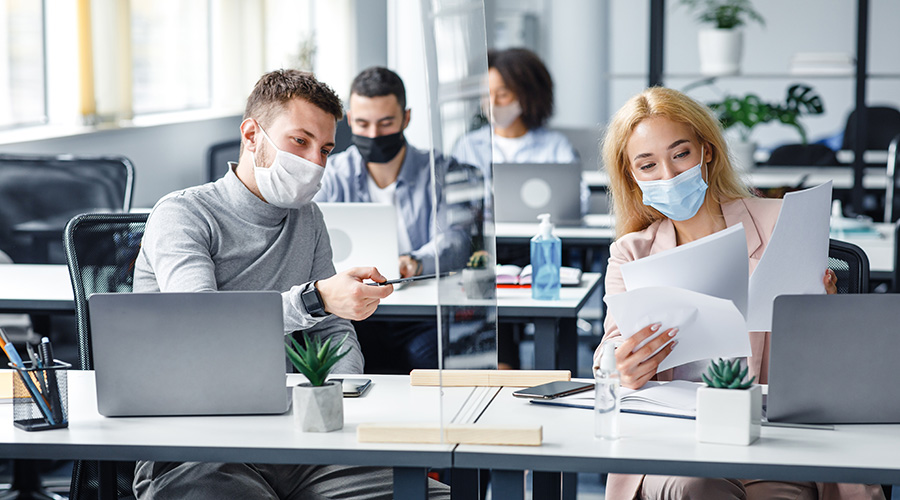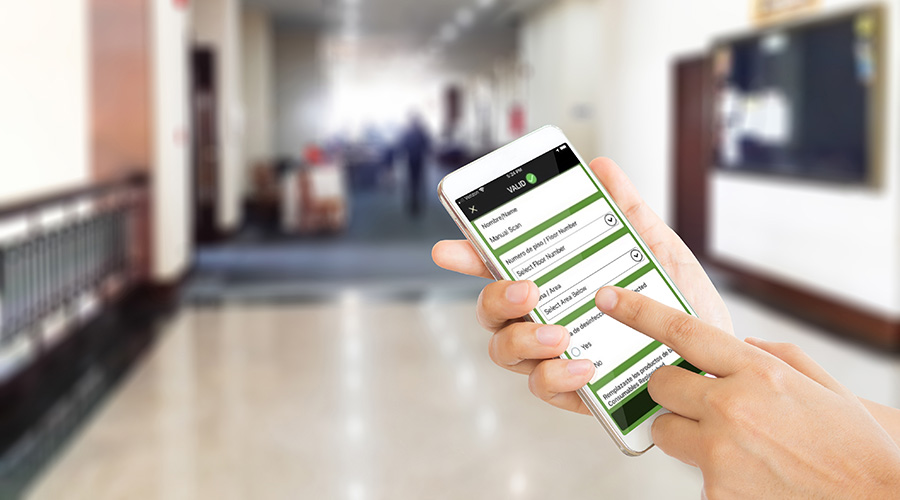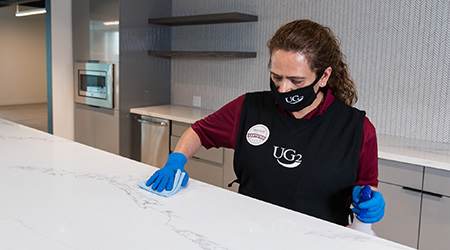SPONSORED
UG2 - Branded Feature
5 Key Components to Successful Post-COVID Service Provider Partnerships
By Bob Desaulniers, Associate Vice President, Strategic Partnerships & Solutions
Most people have spent the last year in some degree of isolation, trying to guard against catching and spreading COVID-19. When we did go out in public, we wore masks and kept six feet apart. While the population at large was figuring out how to function in the new pandemic world, building owners and facility executives were taking drastic measures to create safer environments: researching and deploying the best disinfection and cleaning products, rearranging and spacing out furniture, adding partitions, increasing air filter MERV ratings – and predicting when occupants would be returning to the office.
Now, with COVID-19 vaccinations well underway, plans for reopening are as well. According to a LaSalle Network survey, 70% of business leaders expect to have employees back in the office by fall 2021, phasing them in slowly.
Yet people are understandably hesitant, if not fearful, about returning to the workplace – especially because so much is still unknown about whether or when COVID-19 will be eradicated, and if new variants will keep the virus alive. And with mask and distancing mandates softening and, in some cases, lifted, infection curves and hot spots remain unpredictable.
Under the Spotlight
Commercial tenants, managers, and guests are more knowledgeable than they ever imagined they would be about the novel coronavirus. They're also hyper-aware of how clean everything is or isn't. In order for them to return to facilities, there must be a trust in building owners and facility managers that they are doing everything possible to keep building inhabitants safe.

As you may have experienced, tenants are asking questions that never occurred to them or mattered in the past, such as, What is your MERV filtration rating? Are you using hydrogen peroxide or quaternary disinfectants? What chemicals are in your electrostatic sprayers? What percent alcohol is in your hand sanitizer? What's your standard operating procedure in the event of a positive COVID-19 case?
If they don't feel confident in your knowledge or answers, or with the environment their employees and guests are experiencing, they'll go back to remote working, shopping, and learning.
Clearly, the spotlight and burden on facilities organizations have never been so intense. As we move into this next phase of the pandemic, being able to handle whatever situations arise is critical. Stability is unlikely to return any time soon. The many uncertainties surrounding the pandemic make planning and implementing stepped-up services incredibly challenging.
That's why there's a move to engage outsourcers who are skilled at delivering comprehensive facilities services. According to McKinsey & Company, more than 50% of facilities management was outsourced prior to COVID-19. With so much at stake now, that number is surely on the rise.
Post-Isolation Service Provider Considerations
When evaluating facility services outsourcers, it's critical that property managers and facility executives engage with specialized providers who have the deep-seated knowledge, work ethic, technology expertise, and agility needed to ensure safe, healthy and pristine environments.
Key capabilities to look for include:
1. Resource deployment expertise
These days, there's no plug-and-play solution. Based on building use, many commercial managers have diverted labor to staffing up day shifts and deploying personnel to amenity spaces and common areas to provide enhanced disinfection. This provides the visibility needed to assure tenants you're committed to keeping their environment clean and safe.
The trick is knowing how to best deploy and redeploy resources so they can expertly service your building as situations change. You need service providers who know how to put the right people in the right place at the right time, and ensure they're performing as required.
They also need to balance getting the work done with keeping employees safe. This includes staggering shifts so fewer employees are in break and locker rooms together. And instead of physically proximate work teams, conducting more work independently.
Service providers that have diversified clients in a range of industries, all with different profiles and cleaning needs, have the breadth and depth of experience needed to be creative and effective in how they deploy and adjust resources.

2. Technology Acumen
Advanced technologies can help make facility services more proactive and preventative, while driving the efficiencies needed to contain and reduce costs. Keeping up on these technologies is no easy feat for in-house facility organizations that are stretched thin and working hard.
Service providers can make a huge difference here. Look for providers who are at the forefront of technology. Who are proactive in recommending and providing you with the latest and greatest solutions. And who not only dedicate staff to researching and piloting the newest advances, but also have the foresight and talent to develop their own technologies as needed to help clients deliver impeccable environments.
One of the solutions UG2 developed, for example, is UG2 Disinfection Log (UDL), an app for safety tracking. When a UG2 employee finishes disinfecting a space or high-touch surface, they use their smartphone to tap a near field communication device and chip embedded in their ID badge. Work function and location are recorded in an electronic database for disinfection reporting and tracing purposes.
Another app, UG2 Health Check, or UHC, is a simple, smartphone-based survey that site managers use at the start of every shift, questioning every employee about COVID-19 symptoms and potential exposure, and determining whether it's appropriate for them to work that day.
To help instill confidence in their COVID-19-related safety measures, we often recommend technologies, such as robotic vacuums, scrubbers, and sweepers, that enable a more touchless and autonomous environment. These are visible reminders that the facility management team is continually working to keep spaces clean and people safe.
Giving occupants a feeling of empowerment is also critical. With this mind, UG2 created a Quick Response (QR) code-based solution that lets occupants use their smartphones to initiate location-specific work order requests – for instance, to refill a disinfection station dispenser or clean up a spill.
3. Training Focus
With new technologies and processes being adopted, and facility staff being deployed at different times and places than they're accustomed to, it's critical that facility organizations put a renewed focus on staff training and, where needed, certifications. Everyone needs to be current on best practices, on when and where products can and can't be employed, on how to use new mobile apps, and more.
Investment in people is mission critical to facilities service providers and a key component of that is technical training. Ask facility service outsourcers about their training process. Make sure they provide the coaching, ongoing skills development, and playbooks employees need to be successful at whatever job they're tasked with doing.
4. Partnership mindset
Trust is at the core of every successful relationship. It's what enables organizations to rely on outsourcers to deliver on their promises. It's what builds strong, mutually beneficial partnerships with outcomes that exceed expectations – instead of transactional interactions with, at best, average results.
Whether a new service provider will be a trusted partner isn't always apparent at first. When evaluating outsourcers, look for these tell-tale signs.
- Accountability: They must be willing and able to set clear and specific goals based on agreed-upon KPIs. They need to communicate these KPIs to all employees, measure how they're performing against them on a frequent basis and make that information visible where employees are sure to see it, such where they clock in and out of your facility.
- Transparency: Find out how they keep you abreast of exactly what they're doing, what's working well, and what needs to improve. They should regularly update you on KPI performance and fully own any shortcomings.
- Proactivity: A true partner is always looking ahead to elevate services and outcomes, and never resting on their laurels. Not only do they keep current on and recommend the latest technologies and practices, they stay up-to-speed on evolving COVID-related regulations at federal, state, and local levels, and make sure their team, and your facilities, are adhering to them.
5. Multi-Layered Approach
Whoever you choose, make sure they take a multi-layered, holistic approach to post-isolation facility services. It should include:
- Preparing for return: Making the facility safe for reopening with surface protection, air purification, or general infrastructure changes to accommodate an increasing influx of occupants and guests.
- Operation: Creating and implementing standard operating procedures for everything from communicating disinfection activity, flexibly deploying personnel and reacting safety to a positive case, to ensuring a steady PPE and COVID-19 supply inventory.
- Communication strategy: Notifying occupants about disinfection status and regulations you want them to follow. Signage can go a long way for getting your messages across and keeping them visible. Janitorial staff badges can also help. Bright pins or tags on their clothing saying they're certified in disinfecting protocols and best practices will be noticed and appreciated.
In this time of uncertainty, when planning isn't really possible, budgets are constrained, and the spotlight on facility services is intense, building owners, property and facility managers need all the advantages they can get. By partnering with the right provider, you can build the trust tenants need to confidently return to work, the efficiencies needed to contain costs, and the flexibility and expertise required to turn on a dime.

Bob Desaulniers is Associate Vice President, Strategic Partnerships & Solutions at UG2. He has extensive experience developing innovative solutions for today's facility services challenges. One of founding employees of UG2, Bob spearheads new business development opportunities and executes operations transitions for newly acquired contracts, playing an integral role in growing revenue from zero to $200 million in six years.











